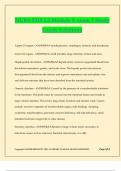NURS 5315 GI Module 9, exam 5 Study
Guide Solutions
Upper GI organs - ANSWER✔✔-mouth,pharynx, esophagus, stomach, and duodenum
Lower GI organs - ANSWER✔✔-small intestine, large intestine, rectum and anus
Hepatoportal circulation - ANSWER✔✔-hepatic artery receives oxygenated blood from
the inferior mesenteric, gastric, and cystic veins. The hepatic portal vein receives
deoxygenated blood from the inferior and superior mesenteric vein and splenic vein
and delivers nutrients that have been absorbed from the intestinal system
Osmotic diarrhea - ANSWER✔✔-Caused by the presence of a nonabsorbable substance
in the intestines. This pulls water by osmosis into the intestinal lumen and results in
large volume diarrhea. This is how mag citrate, lactulose and miralax work. Causes
include: excessive ingestion of nonabsorbable sugars, tube feedings, dumping
syndrome, malabsorption, pancreatic enzyme deficiency, bile salt deficiency, small
intestine bacterial overgrowth or celiac disease
Secretory diarrhea - ANSWER✔✔-Results in large volume losses secondary to
infectious causes such as rotavirus, bacterial enterotoxins, or c-diff.
Copyright ©SOPHIABENNETT 2025 ACADEMIC YEARALL RIGHTS RESERVED. Page 1/14
, Motility diarrhea - ANSWER✔✔-AKA short bowel syndrome. Results from resection of
small intestine or surgical bypass of small intestine, IBS, diabetic neuropathy,
hyperthyroidism, and laxative abuse. Fatty stools and bloating are common in
malabsorption syndrome. Complications include: dehydration, electrolyte imbalance,
metabolic acidosis, weight loss and malabsorption.
Upper GI bleed - ANSWER✔✔-bleeding that occurs in the esophagus, stomach or
duodenum commonly caused by bleeding varices, peptic ulcers or Mallory-Weiss
tear(tearing of esophagus from stomach) Characterized by frank, bright red or coffee
ground emesis.
Lower GI bleed - ANSWER✔✔-Bleeding in the jejunum, ileum, colon or rectum from
inflammatory bowel disease, cancer, diverticula or hemorrhoids. Hematochezia, or the
presence of bright red blood in the stools, suggest what kind of bleed
Peptic Ulcer Disease - ANSWER✔✔-Is a break in the integrity of the mucosa of the
esophagus, stomach or duodenum resulting in exposure of the tissue to gastric acid.
Risk factors include smoking, advanced age, NSAID use, ETOH, chronic disease, acute
pancreatitis, COPD, obesity, socioeconomic status, gastrinoma, and infection with
Helicobacter pylori. S&S: Epigastric pain is worse with eating, melena or hematemesis
Duodenal ulcers - ANSWER✔✔-most common and tend to develop in younger
patients. S&S: epigastric pain that is relieved by food. Patients may have melena(black
and tarry stool) or hematemesis
Copyright ©SOPHIABENNETT 2025 ACADEMIC YEARALL RIGHTS RESERVED. Page 2/14




